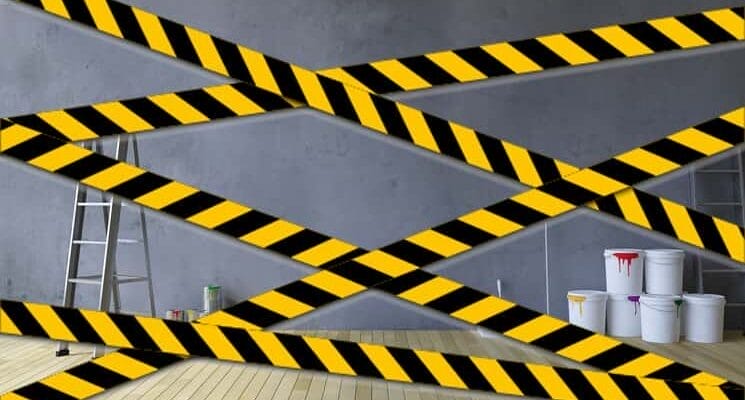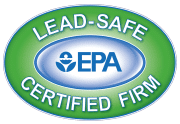
11 Important Home Interior Painting Safety Tips
When painting indoors, prioritize safety above all else. The tools, products, and solvents you choose have a big impact on keeping you and your loved ones safe during your interior painting project.
In this blog, we’ll provide you with essential safety recommendations and precautions homeowners should take to keep themselves and their families safe during an interior painting project. We’ll cover all safety precautions, from job site preparation to clean up and proper storage of paints.
Paint Safety During Surface Preparation
Before you even think about scraping, priming, or the finish coat, it’s crucial to set up your workspace with safety in mind.
Lead Testing
Before embarking on any interior or exterior project that involves sanding or scraping, it’s essential to test for lead. Lead is highly toxic and generally older homes are more likely to have lead-based paint.
According to the United States Environmental Protection Agency, a significant percentage of homes built before 1978 may contain lead. Lead is known to be especially dangerous to children and pregnant women. Be sure to get a lead test, especially if you have a historic home.
If lead paint is present, it is best to hire a painting company that offers lead paint removal services as part of their exterior painting services.
Ventilation and Respirators
The first step throughout any project is to work in a well-ventilated area. Ensure good air circulation by opening doors and windows or using fans. In some cases, when you’re working with specialized decorative paints, such as “Fine Paints of Europe,” you may need a controlled environment to achieve a flawless finish.
Invest in a high-quality respirator or dust mask and an air filtration unit for such situations. Many interior paints these days are water-based and low in VOC ( volatile organic compounds). So with proper ventilation, you will have a safe work area.
Protect Electrical Outlets
When working on walls with electrical outlets, cover them with outlet covers or blue painter’s tape. Products like Socket Blocker can be very useful for this purpose. Socket Blocker will keep your outlets, light switches, and Ethernet ports, and more clear of paint.
Paint Safety During The Painting Stage
It’s now time to start applying the finish coats. Here are some safety tips and steps you should keep in mind.

Choose the Right Paint
Selecting the right type of paint product is crucial. You have two options for interior paint: oil-based or water-based. Most projects will do well with water-based paint, but there are situations where you might prefer oil. When working indoors, try to seal off the workspace as much as possible, from kids and pets. The last thing you want is spilled paint everywhere and dog-covered footprints all over your floors.
Floor Protection
To prevent accidental slips and falls, use a canvas drop cloth or plastic sheets to cover and protect the floor in the painting area. This is especially important if you’re using paints that are difficult to clean up. This will protect your floors from any splashes and paint chips.
Ladder Safety
If you need to reach higher spots, use a step ladder. Ladder safety is critical to prevent serious injuries. Always follow the instructions that come with the ladder. If you’re dealing with the exterior of your home and you are uncomfortable with ladder use, consider hiring a professional, like H.D.F. Painting.
Protect Your Hands and Eyes
When working with solvents for stripping or dilution, protect your hands by wearing disposable gloves. During the sanding, scrapping, and especially if you are working with solvents make sure to wear safety goggles to protect your eyes.
Use Proper Lighting
Adequate lighting in the painting area is essential to ensure you can see your work. Poor lighting can lead to accidents and uneven paint application.
After Completion of Your Project
You have completed your project. What to do next? Following these steps for a complete cleanup.

Disposal of Paint
Disposing of old paint requires a responsible approach, as tossing it in the trash can have harmful consequences. The chemicals in paint can contaminate the environment, seep into the ground, and pose risks to anyone who might come in contact with it. Do not pour oil products down the drain. Treat paint as hazardous waste and contact your town’s hazardous waste collection for proper disposal.
Paint companies like Sherwin-Williams provide a program that makes it easier than ever to recycle paint. Unfortunately, this service is not located in every state. Check their website for more information
You can dispose of surplus latex (water-based) paint if it’s dried out. To dry out a small amount, remove the lid and let it dry in the can. For larger amounts, mix in kitty litter.
Handling Rags Contaminated with Oil Paint or Paint Thinner
Rags covered in oil paint or thinners should not be piled up, as they can spontaneously combust and cause a fire. Keep them in a cool dry area and monitor them until completely dry. Make sure to keep them away from heat sources or open flames.
To safely dispose of rags contaminated with oil paint or paint thinner, place them in a metal container with a secure lid. Fill the container with water and transport it to a hazardous waste collection site.
Paint and Paint Thinner Storage
Home paint products, such as thinners and oil paints, contain volatile organic compounds (VOCs) that can evaporate and release harmful fumes at room temperature. To minimize fume release, store these products in their original containers with tightly sealed caps, away from gas appliances and living spaces. Keep them in a cool, shaded area.
By following these safety tips and precautions throughout your interior painting project, you can ensure the safety of yourself and your loved ones, as well as the longevity of your paint job.
When storing paint, remember to:
If you are located in Massachusetts and need help from a professional interior painter, fill out the form below and we will be in touch.
Get in touch

